K. Stephens's Blog
November 7, 2025
WABI interview with K. Stephens
Thank you to WABI for having me back in the studio and to Bookmarks-Maine for making it happen! A little discussion around the new book and how Nature fights back when mankind crosses the line. Watch the video 

Published on November 07, 2025 02:31
November 6, 2025
BookSirens has my book in a new ARC Book Bundle
 If you're interested in reading By the Dark o' the Moon for free in exchange for an honest review, feel free to click below. And check out the other titles you can choose from in historical fantasy.
If you're interested in reading By the Dark o' the Moon for free in exchange for an honest review, feel free to click below. And check out the other titles you can choose from in historical fantasy.BookSirens
Published on November 06, 2025 08:24
November 5, 2025
Newest review from a librarian on Netgalley.
Thank you to Emily Bonin who reviewed this novel on Netgalley.
#wsite-video-container-803474753867265224{ background: url(//www.weebly.com/uploads/b/2555843-4800... } #video-iframe-803474753867265224{ background: url(//cdn2.editmysite.com/images/util/video... } #wsite-video-container-803474753867265224, #video-iframe-803474753867265224{ background-repeat: no-repeat; background-position:center; } @media only screen and (-webkit-min-device-pixel-ratio: 2), only screen and ( min-device-pixel-ratio: 2), only screen and ( min-resolution: 192dpi), only screen and ( min-resolution: 2dppx) { #video-iframe-803474753867265224{ background: url(//cdn2.editmysite.com/images/util/video... background-repeat: no-repeat; background-position:center; background-size: 70px 70px; } }
#wsite-video-container-803474753867265224{ background: url(//www.weebly.com/uploads/b/2555843-4800... } #video-iframe-803474753867265224{ background: url(//cdn2.editmysite.com/images/util/video... } #wsite-video-container-803474753867265224, #video-iframe-803474753867265224{ background-repeat: no-repeat; background-position:center; } @media only screen and (-webkit-min-device-pixel-ratio: 2), only screen and ( min-device-pixel-ratio: 2), only screen and ( min-resolution: 192dpi), only screen and ( min-resolution: 2dppx) { #video-iframe-803474753867265224{ background: url(//cdn2.editmysite.com/images/util/video... background-repeat: no-repeat; background-position:center; background-size: 70px 70px; } }
Published on November 05, 2025 06:54
October 21, 2025
My Goodreads giveaway is going fast!
Update: The giveaway is only for 100 copies but more than 500 people have signed up. Stay tuned when the giveaway release date is announced! Goodreads Book Giveaway
Goodreads Book Giveaway
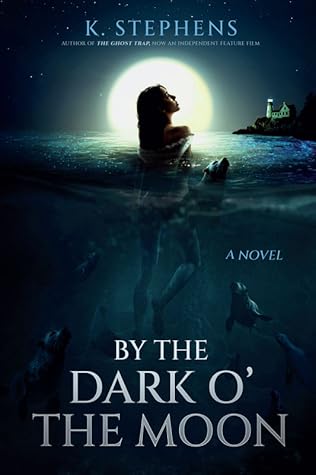 By the Dark o' the Moonby K. Stephens
By the Dark o' the Moonby K. Stephens
 Goodreads Book Giveaway
Goodreads Book Giveaway
 By the Dark o' the Moonby K. Stephens
By the Dark o' the Moonby K. StephensGiveaway ends November 20, 2025.
See the giveaway details at Goodreads.
Enter GiveawayToday is the first day of my Goodreads giveaway, where for a limited time, you can download the novel on Kindle for free. My hope is that those who take me up on this offer will give an honest review either on Amazon or Goodreads (preferably both.) Thanks for participating!
Published on October 21, 2025 04:48
October 13, 2025
Read the Author’s Notes first!
 I’ve been given feedback that for people unfamiliar with selkies and world-building of that era, that it is helpful to read my Author’s Notes first (at the back of the book) before delving into the novel.
I’ve been given feedback that for people unfamiliar with selkies and world-building of that era, that it is helpful to read my Author’s Notes first (at the back of the book) before delving into the novel.Here’s the latest 4-star review left by a reader:
K. Stephen's knits together 1920's New England, prohibition, and the mythological selkie from Celtic and Scottish folklore seamlessly. Her research on dialect of the 1920's leaves the dialog feeling authentic. She truely does a fantastic job transporting the reader back to the 1920's. Another aspect of her writing that adds legitimacy to the time period is how the women are treated by men and how the women act towards each other.
I'm going to call Stephen's world building, "reverse-world building" because I felt like I went back in time. I felt like I was reading a novel written 100 years ago that would still resonate with modern readers. The characters were well developed and with each having their own distinct personalities, brought depth to the plot and belivability to the internal and external conflicts.
I would recommend to readers wanting to read this book to read the Author notes first. My initial read through was a 3 star read because I was unfamiliar with selkies and some of the spellings of words. After reading the Author notes, I was motivated to reread the story and was better equipped to understand and appreciate the hard work the Stephen's put into her choices.
I received an advance review copy for free, and I am leaving this review voluntarily.
Published on October 13, 2025 03:15
October 1, 2025
Limited offer to read the book for free
Reviewers on BookSirens take note Looking for a grounded story steeped in mythology while feeling like you are immersed on a small Maine island in the 1920s? Offer open to reviewers on Goodreads and Amazon. https://booksirens.com/book/EPESJ2I/DY942AP 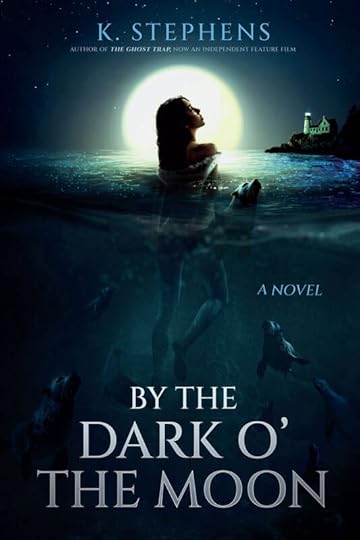 See what others are already saying about the book on my Reviews page.
See what others are already saying about the book on my Reviews page.
 See what others are already saying about the book on my Reviews page.
See what others are already saying about the book on my Reviews page.
Published on October 01, 2025 05:31
September 17, 2025
Looking for book reviewers: free giveaways for a limited time

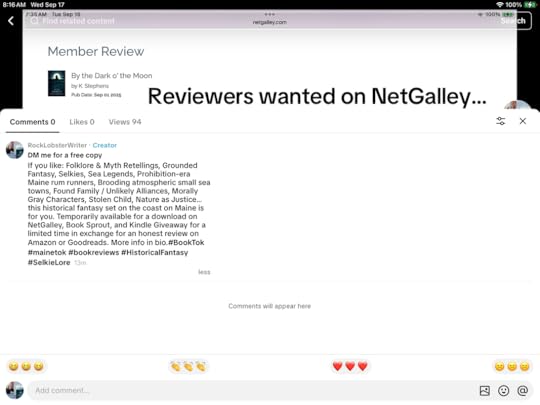 Now that the new book is launched, I’m looking for verified reviewers on Amazon and Goodreads. Until September 28, the book will be available for a free download on NetGalley, so DM me and let me know you saw this post so I know it’s you. On Booksprout, I have approximately 20 more downloads left until October 15. And stay tuned for Kindle Select, a free giveaway will be coming soon.
Now that the new book is launched, I’m looking for verified reviewers on Amazon and Goodreads. Until September 28, the book will be available for a free download on NetGalley, so DM me and let me know you saw this post so I know it’s you. On Booksprout, I have approximately 20 more downloads left until October 15. And stay tuned for Kindle Select, a free giveaway will be coming soon.Thank you my salty friends,
K.
Published on September 17, 2025 05:14
September 5, 2025
Come have a Prohibition cocktail with author K. Stephens
 The Bee's Knees crafted by 8Bells, an Irish bar in Camden, Maine. Photo by K. Stephens Years ago, Lori from The Next Best Book Blog was kind enough to feature The Ghost Trap as a recommendation to her readers, along with an online author chat with me. She has just given me the opportunity to be part of her author series "Books and Booze.https://thenextbestbookblog.blogspot.com The Bee’s Knees
The Bee's Knees crafted by 8Bells, an Irish bar in Camden, Maine. Photo by K. Stephens Years ago, Lori from The Next Best Book Blog was kind enough to feature The Ghost Trap as a recommendation to her readers, along with an online author chat with me. She has just given me the opportunity to be part of her author series "Books and Booze.https://thenextbestbookblog.blogspot.com The Bee’s KneesThis cocktail was invented in the 1920s and its name is slang for “excellent” or “the best.”Gin .75ozLemon Juice .75ozHoney SyrupLemon Twist or Lemon Wedge garnish
So, I’m sitting in an Irish bar called 8Bells, newly opened in Camden, Maine when I see The Bee’s Knees on the menu. What are the odds? My just released Prohibition-era novel set in Maine features the making of the cocktail, The Bee’s Knees in one of the chapters. Read a snippet here. (enter the password: selkies)
Prohibition in Maine isn’t the same as it was for every other state in the nation. For one thing, Maine enacted Prohibition in 1851, almost 70 years before the rest of the states followed in 1920.
Let me back up a bit. I live in Maine (near Camden) and my debut novel about lobstermen called The Ghost Trap, was turned into an award-winning feature film in 2024. I was honored to also write the screenplay and serve an executive producer on the project when we shot it in Midcoast Maine.
OK threading it all together, my next novel By the Dark o’ the Moon took 10 years to finish and also features lobstermen as rumrunners. You see, the other unique angle to Maine and Prohibition is that many lobstermen and fishermen were the first rumrunners in America. Because they were on the coast, they could zip out to Rum Row (three miles out to sea to the international boundary of U.S. territorial waters) grab the forbidden liquor off steamers, ships, and schooners, and zip back in on their modified boats with V-12 engines to the rocky coast way faster than the Coast Guard patrol boats could catch them. They most always did this during the dead of night or “by the dark o’ the moon.”
In my story, Elray Cross, a one-armed jerk of a lobsterman-turned-rumrunner, stands out, not only for his superior distillation of a white whiskey called The White Wraith, but also, for his ruthlessness. Years ago, he captured a selkie’s baby off the storm-ravaged rocks and claimed her for his own. Her stolen sealskin protects him from the wrath of the selkie colony, lurking nearby in the Atlantic waters.
Let’s enjoy a sip of The Bee’s Knees. I ordered it off the menu, and took a sip. It is September now in Camden, and the trees are still vibrantly green, with good weather and 75 degree days still holding on. The wistful feeling is that this is impermanent, and hard frost will start hitting a month from now. But for now, as I enjoy the sweet lemony honey of the cocktail, it feels like endless summer in a glass.
I am planning a four month book tour of Sip & Signs in New England, where I’ll be talking about the novel, its relation to Maine’s famous Prohibition history, about hidden speakeasies I’ve photographed in the Midcoast as a journalist (yes, real attics and basements that once hosted wild secret parties in the '20s before they got renovated into apartments and stores.) With a book like this, it only makes sense to have a sip of something alcoholic and delicious while having a literary chat. My motto, “"Let's not get healthy, let's just get another round."
Cheers and Sláinte to my fellow TNBBC readers and thank you Lori for having me back again!
Published on September 05, 2025 08:04
August 21, 2025
The mysterious speakeasies of Rockland, where history whispers old secrets
I wrote this article for Pen Bay Pilot in 2014, when I was still writing By the Dark o' the Moon. My personal and professional life intertwined after discovering that the owners of a Main Street building in Rockland were renovating their building when they discovered a hidden speakeasy in the attic with vintage alcohol bottles unearthed. I was the only reporter to document this speakeasy before the building was renovated and have done presentations for historical societies based on my photos and articles. This particular speakeasy on Main Street and the one under the Thorndike Hotel both appear in the novel and are brought back to life with rich, historical detail.
 The old speakeasy in ruins seen through the "peek panel" that would have opened to see who the revelers were. Photo © Kay Stephens ROCKLAND — 435 Main Street, the four-story brick building in the heart of downtown Rockland, is being renovated into a multi-use market this summer called Main Street Markets. But that’s not the only fascinating element of this building. It once hosted a mysterious speakeasy on its top floor.
The old speakeasy in ruins seen through the "peek panel" that would have opened to see who the revelers were. Photo © Kay Stephens ROCKLAND — 435 Main Street, the four-story brick building in the heart of downtown Rockland, is being renovated into a multi-use market this summer called Main Street Markets. But that’s not the only fascinating element of this building. It once hosted a mysterious speakeasy on its top floor.
Developer Rick Rockwell has grand plans for the building, aiming to salvage every beam, every brick and every architectural element he can as he works to get the building ready for tenants on the top floor and and a market and retail space on the bottom floors. Rockwell, who grew up in Port Clyde, will offer a consignment space for locally produced food, beer and wine. The cafe will offer salads, juices, shakes and smoothies while other sections of the market will be a one-stop shop for locally harvested seafood, produce and meats. He even has plans for a beer and wine section with a brew pub in the works.
Rockwell was gracious enough to show me the speakeasy that once occupied the attic space of the building back in the early 1900s, during the roaring times of Prohibition.
In 1851, Maine became the first state to ban the manufacture and sale of alcoholic beverages, only allowing an exception for "medicinal, mechanical and manufacturing purposes." Other states followed Maine’s lead and in 1919, the 18th Amendment passed, starting a national Prohibition, which officially became law by January 16, 1920.
It wasn’t surprising then, that in the years leading up to the 18th Amendment, that covert gatherings in small towns such as Rockland would take place in speakeasys, which were nightclubs that sold liquor illegally. In the seafaring towns of Maine, bootleggers and smugglers could get the illegal liquor via Rum Row, a line three miles off the tip of Maine that ran down to the coast of Florida.
According to Rockwell, attics and basements used to be the perfect hiding spots for speakeasys and the cavernous attic room of 435 Main Street was used for exactly that purpose. Currently, all four floors of the building are in the process of renovation. As I walked up the stairs to the third floor, the walls began to tell their own story. Scrawling signatures on the plaster walls testified the presence of the partygoers in that era.
G.G. Rogers wrote “Big Night” on Aug. 25, 1917 and one can only imagine what the big night was. A birthday? Engagement? A grand old hooch-filled evening?
Fallen plaster from ceilings revealed wooden slats in most of the rooms and hallways on the third floor. Finally, we had reached the attic stairs. The spooky stairwell leading up was swimming with dust motes. On both sides of the walls leading up to the door, more signatures — hundreds of them — filled every available space. This was the graffiti of the 1920s, daring to let others know that they existed and yes, they were drinking illegally.
Once we reached the top — just like the movies — there was the door to the speakeasy with the little “knock knock” panel. You could almost hear the music inside and expect to see a burly fellow with a cigar clamped in his teeth squint one eye at you as he opened the panel.
Inside the large, rubble-filled attic, time stood still. Only two small sky lights let in diffuse light. The arched ceiling looked like ribs of a dead whale. Everything had fallen into total disrepair. That’s what happens when a speakeasy goes unused for nearly 100 years.
A few remnants of humanity still existed up there — a broken chair, an old water closet with pull chain and an industrial sink. The knob and tube wiring snaking the walls might have gone unused. Even though the speakeasy had electricity, the kerosene marks on the walls told a different story. Keep the lights as low and you won’t get caught.
This building used to the the Wise & Kimball Block owned by Iddo K. Kimball, which sold stoves and hardware on the first floor in 1853. But nothing I researched could tell me what became of this speakeasy and whether it was eventually busted or abandoned after Prohibition ended.
Many remember the building as the high-end kitchen accessories, the Store, before Sara Foltz sold it to Rockwell. According to Rockwell, she discovered hundreds of old “medicinal” bottles from Boston and Long Island stored in the building and has kept a large cache of them. The few remaining bottles Rockwell possesses have their own nudge-and-wink labels like Beef, Iron and Wine a “Nutritive Tonic”with 20 percent alcohol that “restores the natural vigor that goes with good health.” Another bottle labeled P&S Tonic, for physicians and surgeons claiming to be “an approved formula especially indicated in run down and weakened conditions.” A full tablespoon was recommended three times daily.
A few doors down on Main Street, the Thorndike building basement, another reputed speakeasy in Rockland, is also being renovated at the same time this spring. All I could see peeking in from the street side door was a big empty basement room, gutted to the studs. If there was ever any writing on the walls or remnants of its illicit history, it’s all gone now. Several attempts to reach the owners directly were unsuccessful, but I discovered through the Rockland Historical Society that in 1854 the Thorndike Hotel was built by William Thorndike, who happened to be a mariner, a merchant and an owner of stables.
He opened the hotel in 1855, with a a livery stable attached and charged only $1 a day for a room. According to Ann Morris’ historical booklet A Walk Along Main Street, the Thorndike Hotel was considered “a first class hotel...patronized by the large number of steamboat travelers and the public generally.”
It’s interesting to note that only a few short years after Maine banned the manufacture and sale of liquor, this particular hotel became popular. Was it because there was a secret basement entrance to the speakeasy? That’s what local rumors have long suggested. In 1937 (not long after Prohibition ended), the Thorndike Hotel was taken over by the U.S. Navy and the Coast Guard. The basement room was officially recognized as the Rainbow Room and became a favorite saloon for many in the area.
According to local historian Gil Merriam, when he was a boy working at the Strand Theater, everyone referred to The Rainbow Room as “The Passion Pit.”
People always say “if these walls could talk.” I imagine if they did, the sound would be of hundreds of people shouting their own names and the dates that they could be found carousing in back rooms that only a select few knew about. “I was here!” they’d say. And that’s all we’ll ever know before the carpenters come in and wipe away the past.
 Now go back to 1927 and picture this room in good shape, hopping with young people enjoying whiskey and beer with a band in the corner. Photo © Kay Stephens
Now go back to 1927 and picture this room in good shape, hopping with young people enjoying whiskey and beer with a band in the corner. Photo © Kay Stephens 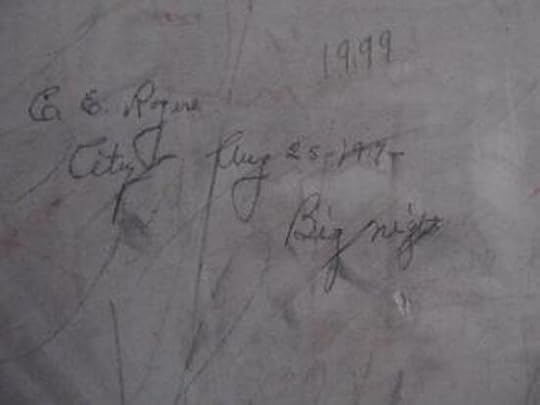 The stairway leading up to the speakeasy had hundreds of scrawled signatures during Prohibition. I got the photos before the walls were painted. Photo © Kay Stephens
The stairway leading up to the speakeasy had hundreds of scrawled signatures during Prohibition. I got the photos before the walls were painted. Photo © Kay Stephens 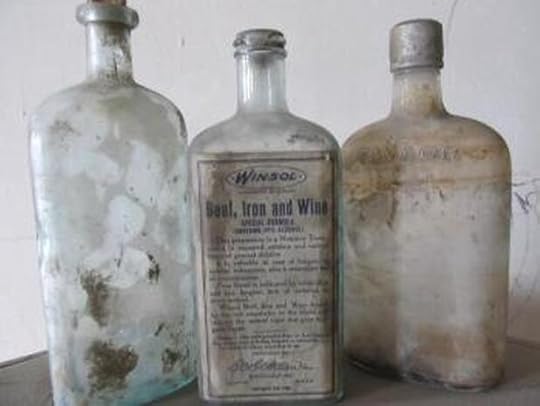 Vintage alcohol bottles discovered upon renovation. Photo © Kay Stephens
Vintage alcohol bottles discovered upon renovation. Photo © Kay Stephens  The Thorndike Hotel circa 1915. The speakeasy would have been in the basement past the candystriped awnings on Tillson Ave. (Photo courtesy Wikimedia Commons)
The Thorndike Hotel circa 1915. The speakeasy would have been in the basement past the candystriped awnings on Tillson Ave. (Photo courtesy Wikimedia Commons)
 The old speakeasy in ruins seen through the "peek panel" that would have opened to see who the revelers were. Photo © Kay Stephens ROCKLAND — 435 Main Street, the four-story brick building in the heart of downtown Rockland, is being renovated into a multi-use market this summer called Main Street Markets. But that’s not the only fascinating element of this building. It once hosted a mysterious speakeasy on its top floor.
The old speakeasy in ruins seen through the "peek panel" that would have opened to see who the revelers were. Photo © Kay Stephens ROCKLAND — 435 Main Street, the four-story brick building in the heart of downtown Rockland, is being renovated into a multi-use market this summer called Main Street Markets. But that’s not the only fascinating element of this building. It once hosted a mysterious speakeasy on its top floor.Developer Rick Rockwell has grand plans for the building, aiming to salvage every beam, every brick and every architectural element he can as he works to get the building ready for tenants on the top floor and and a market and retail space on the bottom floors. Rockwell, who grew up in Port Clyde, will offer a consignment space for locally produced food, beer and wine. The cafe will offer salads, juices, shakes and smoothies while other sections of the market will be a one-stop shop for locally harvested seafood, produce and meats. He even has plans for a beer and wine section with a brew pub in the works.
Rockwell was gracious enough to show me the speakeasy that once occupied the attic space of the building back in the early 1900s, during the roaring times of Prohibition.
In 1851, Maine became the first state to ban the manufacture and sale of alcoholic beverages, only allowing an exception for "medicinal, mechanical and manufacturing purposes." Other states followed Maine’s lead and in 1919, the 18th Amendment passed, starting a national Prohibition, which officially became law by January 16, 1920.
It wasn’t surprising then, that in the years leading up to the 18th Amendment, that covert gatherings in small towns such as Rockland would take place in speakeasys, which were nightclubs that sold liquor illegally. In the seafaring towns of Maine, bootleggers and smugglers could get the illegal liquor via Rum Row, a line three miles off the tip of Maine that ran down to the coast of Florida.
According to Rockwell, attics and basements used to be the perfect hiding spots for speakeasys and the cavernous attic room of 435 Main Street was used for exactly that purpose. Currently, all four floors of the building are in the process of renovation. As I walked up the stairs to the third floor, the walls began to tell their own story. Scrawling signatures on the plaster walls testified the presence of the partygoers in that era.
G.G. Rogers wrote “Big Night” on Aug. 25, 1917 and one can only imagine what the big night was. A birthday? Engagement? A grand old hooch-filled evening?
Fallen plaster from ceilings revealed wooden slats in most of the rooms and hallways on the third floor. Finally, we had reached the attic stairs. The spooky stairwell leading up was swimming with dust motes. On both sides of the walls leading up to the door, more signatures — hundreds of them — filled every available space. This was the graffiti of the 1920s, daring to let others know that they existed and yes, they were drinking illegally.
Once we reached the top — just like the movies — there was the door to the speakeasy with the little “knock knock” panel. You could almost hear the music inside and expect to see a burly fellow with a cigar clamped in his teeth squint one eye at you as he opened the panel.
Inside the large, rubble-filled attic, time stood still. Only two small sky lights let in diffuse light. The arched ceiling looked like ribs of a dead whale. Everything had fallen into total disrepair. That’s what happens when a speakeasy goes unused for nearly 100 years.
A few remnants of humanity still existed up there — a broken chair, an old water closet with pull chain and an industrial sink. The knob and tube wiring snaking the walls might have gone unused. Even though the speakeasy had electricity, the kerosene marks on the walls told a different story. Keep the lights as low and you won’t get caught.
This building used to the the Wise & Kimball Block owned by Iddo K. Kimball, which sold stoves and hardware on the first floor in 1853. But nothing I researched could tell me what became of this speakeasy and whether it was eventually busted or abandoned after Prohibition ended.
Many remember the building as the high-end kitchen accessories, the Store, before Sara Foltz sold it to Rockwell. According to Rockwell, she discovered hundreds of old “medicinal” bottles from Boston and Long Island stored in the building and has kept a large cache of them. The few remaining bottles Rockwell possesses have their own nudge-and-wink labels like Beef, Iron and Wine a “Nutritive Tonic”with 20 percent alcohol that “restores the natural vigor that goes with good health.” Another bottle labeled P&S Tonic, for physicians and surgeons claiming to be “an approved formula especially indicated in run down and weakened conditions.” A full tablespoon was recommended three times daily.
A few doors down on Main Street, the Thorndike building basement, another reputed speakeasy in Rockland, is also being renovated at the same time this spring. All I could see peeking in from the street side door was a big empty basement room, gutted to the studs. If there was ever any writing on the walls or remnants of its illicit history, it’s all gone now. Several attempts to reach the owners directly were unsuccessful, but I discovered through the Rockland Historical Society that in 1854 the Thorndike Hotel was built by William Thorndike, who happened to be a mariner, a merchant and an owner of stables.
He opened the hotel in 1855, with a a livery stable attached and charged only $1 a day for a room. According to Ann Morris’ historical booklet A Walk Along Main Street, the Thorndike Hotel was considered “a first class hotel...patronized by the large number of steamboat travelers and the public generally.”
It’s interesting to note that only a few short years after Maine banned the manufacture and sale of liquor, this particular hotel became popular. Was it because there was a secret basement entrance to the speakeasy? That’s what local rumors have long suggested. In 1937 (not long after Prohibition ended), the Thorndike Hotel was taken over by the U.S. Navy and the Coast Guard. The basement room was officially recognized as the Rainbow Room and became a favorite saloon for many in the area.
According to local historian Gil Merriam, when he was a boy working at the Strand Theater, everyone referred to The Rainbow Room as “The Passion Pit.”
People always say “if these walls could talk.” I imagine if they did, the sound would be of hundreds of people shouting their own names and the dates that they could be found carousing in back rooms that only a select few knew about. “I was here!” they’d say. And that’s all we’ll ever know before the carpenters come in and wipe away the past.
 Now go back to 1927 and picture this room in good shape, hopping with young people enjoying whiskey and beer with a band in the corner. Photo © Kay Stephens
Now go back to 1927 and picture this room in good shape, hopping with young people enjoying whiskey and beer with a band in the corner. Photo © Kay Stephens  The stairway leading up to the speakeasy had hundreds of scrawled signatures during Prohibition. I got the photos before the walls were painted. Photo © Kay Stephens
The stairway leading up to the speakeasy had hundreds of scrawled signatures during Prohibition. I got the photos before the walls were painted. Photo © Kay Stephens  Vintage alcohol bottles discovered upon renovation. Photo © Kay Stephens
Vintage alcohol bottles discovered upon renovation. Photo © Kay Stephens  The Thorndike Hotel circa 1915. The speakeasy would have been in the basement past the candystriped awnings on Tillson Ave. (Photo courtesy Wikimedia Commons)
The Thorndike Hotel circa 1915. The speakeasy would have been in the basement past the candystriped awnings on Tillson Ave. (Photo courtesy Wikimedia Commons)
Published on August 21, 2025 06:41
July 2, 2025
What's popping this summer?
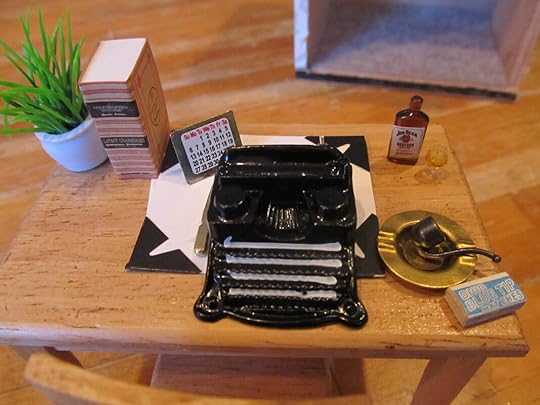 Well, let me tell you. I thought the summer of 2024 was bonkers with the film coming out and six film premieres all over the country! This summer I told myself, "Slow down, take it easy." But, obviously I can't seem to do that.
Well, let me tell you. I thought the summer of 2024 was bonkers with the film coming out and six film premieres all over the country! This summer I told myself, "Slow down, take it easy." But, obviously I can't seem to do that.Most you you coming here know me from my debut novel, The Ghost Trap, (Leapfrog Press, 2009) which got a major revival and new cover when turned into an award-winning feature film in 2024 after working on it for six years. You can now watch the Maine-shot film on multiple platforms for $3.99. See where. If you're in Maine, the movie is coming back to the Strand in Rockland for Maine Lobster Festival Week!
I'm currently working with Maine Authors Publishing to publish my next novel, By the Dark o' The Moon, (forthcoming, fall, 2025) which has--just like The Ghost Trap--taken me at least 10 years to write and research. I'm not exactly prolific, but I'm thorough.
Here's what else is happening this summer.
June 21-Orono Performing Arts Center-Orono We did a screening of The Ghost Trap with a Q&A from me afterward.
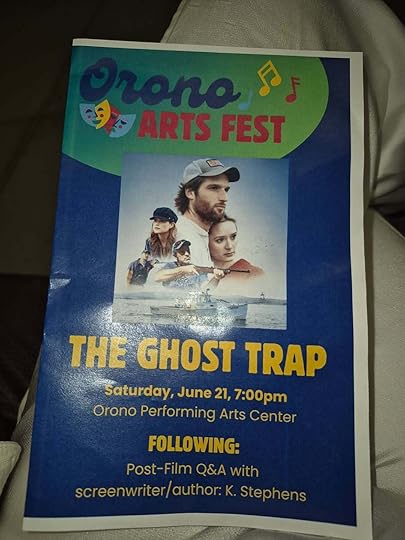 Waiting backstage to go on after the credits roll. July 1-Rockland
Waiting backstage to go on after the credits roll. July 1-RocklandThe Rockland Public Library is featuring the works of my side project, Tonic of the Woods, with hand-crafted shadowboxes and miniature literary sculptures using natural forest materials, old books, wood, and repurposed items.
The exhibition spanned more than seven years to create and features 10 custom miniature shadowboxes and sculptures. Each comes with a story to lure the viewer deeper into the scene. The enchantment of each tiny scene may spur people to pick up the book it was based on and read more.
Anyone who has a longstanding love for books and miniatures, this exhibit is for you.
An informal artist's reception will be held on Friday, June 11 from 2 to 4 p.m.
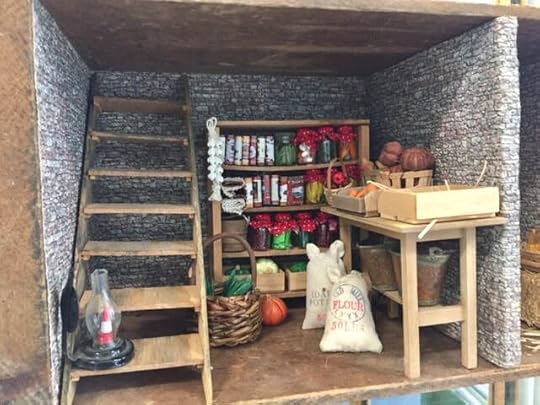 A miniature scene in a vintage box created from a chapter in By the Dark o' the Moon, where a farmer hides illicit booze behind a false wall in his root cellar. July 2- OystHERS Raw Bar Book Club- Bath Two sisters, daughters of a lobsterman who co-own Oys-HERS, read the book last year and invited me to be the first book club pick of the season. I had a blast chatting with about 20 book club members with gorgeous views of the Kennebec River. The prosecco and conversations flowed and it was a thoroughly fun evening.
A miniature scene in a vintage box created from a chapter in By the Dark o' the Moon, where a farmer hides illicit booze behind a false wall in his root cellar. July 2- OystHERS Raw Bar Book Club- Bath Two sisters, daughters of a lobsterman who co-own Oys-HERS, read the book last year and invited me to be the first book club pick of the season. I had a blast chatting with about 20 book club members with gorgeous views of the Kennebec River. The prosecco and conversations flowed and it was a thoroughly fun evening.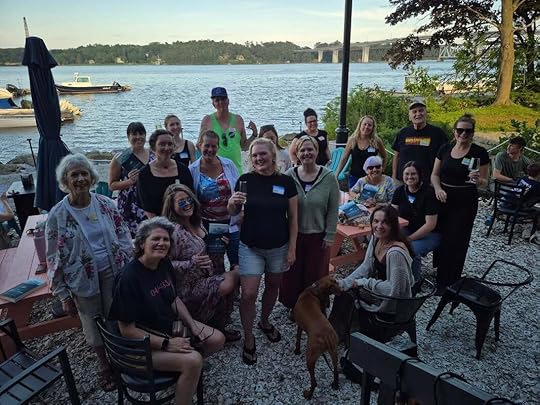 The book club members and I enjoyed an evening talking about the book and movie. Coming up in August
The book club members and I enjoyed an evening talking about the book and movie. Coming up in August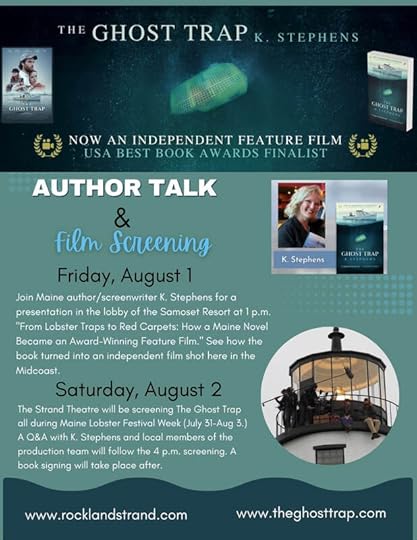 Coming up in September
Coming up in SeptemberThe Maine Authors Publishing catalogue comes out September 1 and the I'll be announcing more on the new book launch soon!
Published on July 02, 2025 07:35



